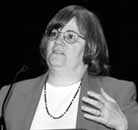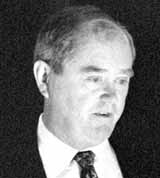 |
|
The Nature of Science by Mike Perricone Science is a system for weighing evidence; a set of instructions for how to think, not what to think, with the firm rule that a theory is valid only if it is capable being disproved. Science beckons us to retrieve specimens and bring them back to show our colleagues, and to argue over the evidence: the livelier the argument, the better the results. Science aims to "gradually reduce prejudice," as atomic scientist Niels Bohr once said. It leads us, physicist Richard Feynman said, to appreciate "the humility of the intellect": we learn how much we don't know. Science, in all these aspects, begins with an act of faith. "The act of faith is that we can understand the universe," said Fermilab theoretical physicist Chris Quigg, opening the Symposium on the Nature of Science at Wilson Hall's Ramsey Auditorium on Saturday, March 18.
"The motivation rose from the challenges about what to teach in science classes," said Bardeen, head of Fermilab's Education Office. "Our goal was to present a positive picture of what science really is." That picture was positively compelling, in the eyes of a teacher who attended. "Fermilab assembled gentle, human, entertaining scientists who were also some of the best minds in the world," said Alis Cheney, who teaches at a private elementary school in Chicago. "It was the best workshop I've ever attended." But if not the major theme, the issue of evolution represented an important sub-theme of the day. In his talk, "Finch Beaks Break More Than Seeds," evolutionary biologist David J. Anderson of Wake Forest University admitted: "Evolution has a perception problem." Anderson detailed his own work in the Galapagos Islands, replicating Charles Darwin's original observations of variation in finch beak sizes depending on environmental conditions. His findings showed once again that the number of offspring depends on the parents' success at life skills in the surrounding environment. Dry conditions, for example, yield a greater than normal proportion of large seeds, leading to a greater proportion of finches with large beaks for cracking those large seeds. As for the finch beaks breaking more than seeds, Anderson said they "crack woolly thinking about evolution." He stressed the years of work, of banding and following the birds, of observing what they eat and how fast they change with conditions. It is the painstaking process of compiling evidence, springing from the act of faith that we can understand the universeˇ in this case, the finch world. When we can't observe, when data buried in the past leave experiments beyond our reach, then "sometimes analogy is all we have," said Paul Sereno, the renowned paleontologist and hunter of dinosaurs (the precise term is "sauropods"), from the University of Chicago. In addition to collecting and cataloging fossils, Sereno is adept at experiment-by-analogy. To find out how large dinosaurs might have moved and maintained their balance, he journeyed to an exotic locale: a zoo in Toronto. Sereno videotaped motion studies of an elephant, then transported the elephant to a truck-weighing station to measure the weight distribution between front and rear "axles" (result: 60 percent front, 40 percent rear). Comparing the known quantity of the elephant with fossils and footprints of sauropods yields clues to the similarities between these huge creatures separated by such vast expanses of time.
"Most of the universe is not matter as we understand it," Kolb said. "We're looking for the secret ingredient by recreating the primordial soup in the laboratory." The laboratory, specifically, is the Fermilab particle accelerator complex, where increasing levels of energy correspond to earlier stages in the formation of the universe. Those stages bring us to the ultimate questions of where we come from, and why we are hereˇquestions that may seem to go beyond science. Princeton University astrophysicist James Peebles demonstrated that the scientific "act of faith" also draws thinkers dedicated to religious faith. He cited physicist Georges Edouard Lemaitre, a Belgian abbot of the Catholic Church, who combined Einstein's relativistic theories with Hubble's data on the recessional velocity of galaxies to postulate that an expanding universe must contain "fossil evidence" of its early state. A key element in the Big Bang theory, Lemaitre's theory has been borne out, not by cosmic rays as he anticipated, but by the discovery of the cosmic background radiation. Timothy Toohig personifies a "scientist of faith." A physicist working for the Department of Energy, he is also a Jesuit priest and a professor at Boston College. In his talk, "Physics Research: Search for God," Toohig cautioned that science and religion are separate and very different, and that trying to combine them has historically not been beneficial for either one. Yet he noted a striking similarity. "Both religion and science contain a powerful sense that there is more there than we currently understand," Toohig explained. "In science, this is what leads us, for example, to build new accelerators, as a way to reach beyond what we know, toward discoveries that we believe lie beyond."
"We'd be disappointed if all our theories proved to be wrong, but we'd also be disappointed if they were all right," Sereno said. "We're truth-seekers." |
| last modified 4/14/2000 email Fermilab |
FRLsDFx9eyfrPXgV
 Organized and conducted by Fermilab's Education Office, the Symposium on the Nature of Science brought together more than 425 educators from communities surrounding Fermilab, from Chicago, from neighboring states (Iowa, Wisconsin, Michigan and Indiana) and from as far away as New York. The Illinois State Board of Education supported the symposium with a grant to Friends of Fermilab.
Organized and conducted by Fermilab's Education Office, the Symposium on the Nature of Science brought together more than 425 educators from communities surrounding Fermilab, from Chicago, from neighboring states (Iowa, Wisconsin, Michigan and Indiana) and from as far away as New York. The Illinois State Board of Education supported the symposium with a grant to Friends of Fermilab.
 The presentations ranged from dark matter to dinosaurs, from finch beaks to the big bang, from cosmochemistry to culture clashes, from education strategies to--yes, to evolution. The country's scientific community has been protesting the Kansas State Board of Education's exclusion of evolution and cosmology from its code of standards, but organizer Marge Bardeen cited broader goals for the symposium.
The presentations ranged from dark matter to dinosaurs, from finch beaks to the big bang, from cosmochemistry to culture clashes, from education strategies to--yes, to evolution. The country's scientific community has been protesting the Kansas State Board of Education's exclusion of evolution and cosmology from its code of standards, but organizer Marge Bardeen cited broader goals for the symposium.
 There are no greater expanses of time and space than the universe itself. As Fermilab astrophysicist Rocky Kolb explained, telescopes are like time machines. When we view the Andromeda galaxy, we see it as it was two million years ago: its light has taken that long to reach us. Looking farther out into space takes us further back in time, but reaching toward the limits of the universe's estimated 14-billion-year lifespan takes us to the realm of what Kolb called "the primordial soup."
There are no greater expanses of time and space than the universe itself. As Fermilab astrophysicist Rocky Kolb explained, telescopes are like time machines. When we view the Andromeda galaxy, we see it as it was two million years ago: its light has taken that long to reach us. Looking farther out into space takes us further back in time, but reaching toward the limits of the universe's estimated 14-billion-year lifespan takes us to the realm of what Kolb called "the primordial soup."
 The daylong conference featured four general sessions in Ramsey Auditorium, including a wrap-up session, and 10 parallel sessions in smaller conference rooms around Wilson Hall. Whether their expertise was in primate social systems, or in science projects for K-12 classrooms, the speakers shared Quigg's view of science as "radically conservative:" surrendering assumptions only when they're proven wrong, yet celebrating doubt.
The daylong conference featured four general sessions in Ramsey Auditorium, including a wrap-up session, and 10 parallel sessions in smaller conference rooms around Wilson Hall. Whether their expertise was in primate social systems, or in science projects for K-12 classrooms, the speakers shared Quigg's view of science as "radically conservative:" surrendering assumptions only when they're proven wrong, yet celebrating doubt.